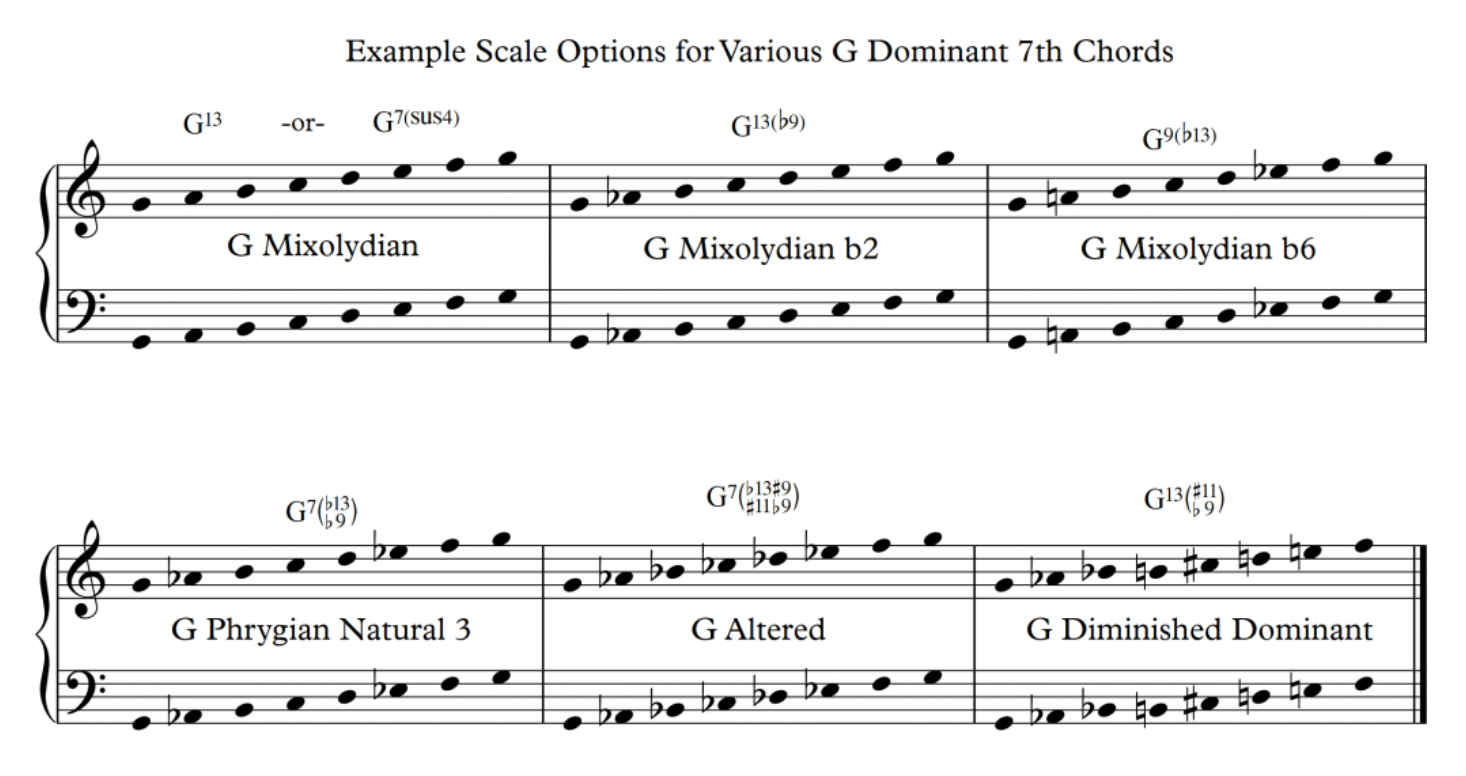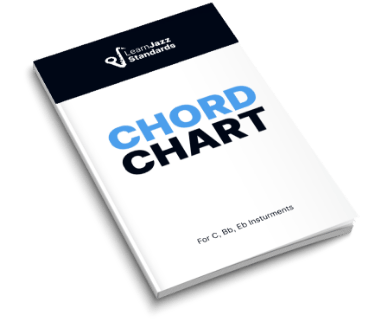Anyone who has played jazz or leafed through a jazz fakebook or “real book” probably has noticed that the dominant 7th chord is one of the most common chords musicians encounter in jazz standards.
However, not all dominant seventh chords have the same upper structures or functions.
What a jazz musician plays over a dominant seventh chord varies widely. The melodies we play over dominant seventh chords and the scales they derive from depend on:
- the specific type of dominant chord
- the function of the dominant chord in its musical context
That’s what we’ll explore in this post. We’ll break down three varieties of dominant seventh chords that are most commonly found in jazz standards. Also, we’ll look at some of the different scale options you can use over the different “flavors” of dominant seventh chords.
If you want to unlock the secrets of dominant chords and other essential jazz chords like the half-diminished seventh chord, the diminished seventh chord, and the major minor seventh chord, then you need to check out the Learn Jazz Standards Inner Circle.
When you join the Inner Circle, you gain access to a treasure trove of incredible jazz education resources, including masterclasses, workshops, and courses taught by professional jazz musicians. The Inner Circle gives you all the tools you need to become the best jazz player you can be!
Come see what the Inner Circle is all about!
Table of Contents
Dominant 7th Chord Review
What is a Dominant Seventh Chord? How is a Dominant Seventh Chord Theoretically Derived?
This is likely a review for many jazz musicians, but it’s helpful to ensure we have our foundation covered before moving on to more advanced concepts. We’ll look at dominant chords from a few different perspectives. Hopefully, one of these will resonate with how you hear and think about dominant sevenths.
The Function of the Dominant Chord
- Tension and Release: Dominant chords play a vital role in creating tension and anticipation. This tension often begs for resolution, typically satisfying when it moves to the tonic chord (I). Dominant seventh chords have a diminished triad built into them, which helps create the tension.
- Direction and Movement: Because of this inherent tension, dominant chords are pivotal in guiding the harmonic direction of a piece through voice leading, where the voices in harmony move in a stepwise direction.
- Modulation and Transition: Dominants can also be used to transition or modulate to a new key. Moving to a new key can introduce freshness and variety to a music composition.
Ways To Think Of The Basic Dominant Seventh Chord
A basic dominant seventh chord (with no extensions – i.e., no 9ths, 11ths, or 13ths) can be thought of in three different ways:
1. Tonality (or Theoretically)
You can build a diatonic seventh chord starting from the 5th note of the major scale. To refresh the major scale modes, check out this guide to the major modes.
The name “dominant” comes from classical music theory. In the classical world, you can build a chord from every scale degree of the major scale. These diatonic chords make up every major key and minor key.
On the left, you’ll see the notes of a C major scale and each note’s Roman numeral. You’ll see that same C major scale harmonized into diatonic triads on the right.
![3 Dominant 7th Chord Types All Jazz Musicians Encounter 2 C major scale [C-D-E-F-G-A-B-C] as a scale and as a chord scale.](https://images.surferseo.art/515252b2-1b9a-4eba-9911-95eca7b07e4f.png)
The chord built from the root or the 1st note of the major scale is referred to as the “tonic” chord or the “I” chord. The chord built from the fifth scale degree of the major mode is called the “dominant” or the V chord. In fact, each of the scale degrees has its own name:
Scale Degrees of the C Major Scale
- Tonic: first note (or C)
- Supertonic: second note (or D)
- Mediant: third note (or E)
- Subdominant: fourth note (or F)
- Dominant: fifth note (or G)
- Submediant: sixth note or (A)
- Leading Tone: seventh note (or B)
However, none of the triads in the image above are dominant seventh chords. The G major chord is functionally a dominant triad but not a dominant 7th chord.
To build a seventh chord, we need to stack an additional third onto each diatonic triad, giving us four notes per chord. Check out this Ultimate Guide To 7th Chords for a refresher!

In the key of C major, the 5th scale degree (the dominant) is G. If you stack diatonic 3rds (meaning notes derived from the key of C major) on top of G to build a seventh chord, you end up with a G7 chord.
2. Major Triad + Minor Seventh Interval (b7)
A dominant seventh chord can also be considered a major triad plus an added flat seventh (a b7) above the chord’s root.
![3 Dominant 7th Chord Types All Jazz Musicians Encounter 4 Building a dominant 7th chord by taking a major triad and adding a flat seventh [G-B-D-F]](https://images.surferseo.art/ac2a2f58-dd61-4f59-b67d-33e3eec5845a.png)
Note: the “lowered” seventh is in comparison to a “major” or “natural” seventh. For example, the “natural” or “major” seventh above the chord root (G) is F#, so F natural is the minor seventh interval or b7. With this method, you start with a G major triad (G, B, D) and add a b7 – F natural.
3. Intervallic Relationships
A dominant seventh chord can be defined purely in terms of stacked thirds. You start with the chord in root position – with the chord’s root as the bass note/lowest note, and stack thirds – first a major third, followed by two minor thirds.

- G: Root Note
- B: Major Third
- D: Perfect Fifth
- F: Minor Seventh
Extended Dominant Seventh Chords in Jazz
In jazz music, most dominant seventh chords have specific chordal extensions.
In the most generic terms, a dominant seventh chord, regardless of its extensions, can be defined as:
- Any chord with a natural (or “major”) 3rd and a lowered seventh (or “flatted 7th” or “b7”) above the root of the chord.
Here is a diatonic dominant seventh chord with its complete unaltered extensions:

A basic seventh chord includes the root, 3rd, 5th, and 7th, but even the most basic modern jazz voicings often have 9ths, 11ths, and 13ths in most chords. Here are some diatonic extended dominant seventh chords:

Early jazz musicians and pre-swing era players such as “Jelly Roll” Morton and Bix Beiderbecke were already exploring more colorful harmonies with extended chords. Still, more complex jazz harmony took off when composers such as Duke Ellington came along in the big band era.
As jazz’s harmonic vocabulary expanded and developed in the late swing era (roughly in the late 1930s), jazz musicians who spearheaded the movement we now call bebop began exploiting and altering the more “colorful” extensions of chords, especially 9ths and 13ths.
Bebop musicians especially famously began exploiting and altering the extensions of chords in jazz harmony.
BEFORE YOU CONTINUE...
If you struggle to play amazing jazz solos and want to learn the secret strategies the pros are using to improvise, our free guide will get you on the right track.

Common Extension: Dominant #11 Chords
One of the two most common alterations to upper extensions involves only raising the 11th to get a dominant 7(#11) chord.
This harmonic maneuver probably came from the influence of French Impressionistic composers such as Claude Debussy had on jazz musicians (for just one example, listen to Debussy’s Images and note the harmonic similarities between his writing and the piano music of Bix Beiderbecke and Thelonious Monk).
There are a few ways to think of this chord:
This chord comes from the 4th scale degree of the melodic minor scale (corresponding to the Mixolydian #4 or “Lydian Dominant” mode derived from the melodic minor mode system). Check out this guide to the melodic minor scale to learn more.


The Lydian dominant sound is essential to jazz music. Any jazz tune that lands on a dominant II chord in its progression can use the Lydian dominant sound.
Another way to imagine the dominant #11 chord is to visualize it as a slash chord or a polychord.
- Slash Chords specify a chord over a particular bass note.
- Polychords involve playing two chords simultaneously for a richer harmonic texture.
When we add an A major triad over a G triad (or over a G root in the case of the slash chord), we wind up with the dominant #11 sound.

Common Extensions: Altered Chords
Other alterations involve using lowered and raised 9ths, a raised 11th, and a lowered or natural 13th. Whenever you see a G7alt, it can mean so many things.
Here are a few possibilities with specific chord voicings.

Tonality and the Dominant Seventh Chord
It’s important to note that there is a tritone between the major third scale degree and the minor seventh scale degree of a dominant seventh chord. This interval relationship helps define the chord’s quality and helps create the tension that makes these types of chords powerful in music.
This tension helps create and define tonality since the resolution of the diminished triad during a V7-I harmonic progression creates the sense of gravity, inevitably, and “homecoming” (i.e., tension and release) of a V7-I chord progression.
The complicated thing about jazz harmony is that some of jazz’s harmonic vocabulary is borrowed from or influenced by classical music, and some of it directly defies classical music’s conventions.
Sometimes, we see V7-I chord progressions in tonal contexts in jazz, as is often the case in II-V-I progressions in Great American Songbook Standards, for example. Other times, we see dominant seventh chords that do not resolve V7-I in tonal contexts.
For example, many of Thelonious Monk’s compositions feature dominant seventh chords that do not resolve with the root moving up a perfect 4th or down a perfect 5th (see his compositions “Ask Me Now,” “Well You Needn’t,” and “I Mean You”).
So, our task as jazz musicians is to identify what dominant seventh we’re dealing with and where it’s resolving. These facts will influence the function of the seventh chord and, therefore, affect how we approach improvising over it.
The 3 Most Common Flavors of Dominant Seventh Chords (And What To Play Over Them)
Now that we have all of that background information covered, let’s break these various types of dominant seventh chords into three major categories or “flavors” based on their function:
1. Fully diatonic seventh chords with no alterations (regardless of where they resolve)
- If there are no alterations, the strongest option is to use the diatonic (Mixolydian) mode. This is especially the case for modal dominant chords and especially dominant seventh chords with a suspended 4th (G7sus4), which are generally diatonic in their implication and often appear in modal jazz contexts.
- However, if it is part of a chord progression resolving V7-I, you can use the dominant seventh bebop scale.
2. Partially altered seventh chords that don’t resolve V7-I (i.e., with the root movement up a 4th or down a 5th)
- The most common example is the dominant seventh #11 chord, where you’d use the 4th mode of the melodic minor, also called the Mixolydian #4 or “Lydian Dominant.”
- You can also often get away with playing the whole tone scale (all whole steps built from the root) over this chord because of the strong pair of tritones created between the 3rd and 7th and between the root and #11 (or #4 if you’re thinking in terms of the scale).
3. Altered dominant chords that resolve V7-I
You have a handful of scale choices here. The one you choose will depend on a combination of the specific alterations indicated by the chord symbol and what the song’s melody suggests if you want to stick close to the originally suggested harmony of the composition. Here are your scale options:
- The altered scale: (the 7th mode of melodic minor – so C# melodic minor played from C) – especially when you have a b13 and an altered 9th
- “Diminished dominant:” – or the diminished scale starting with a half step – especially when you have a natural 13 and #11 with an altered 9th
- Mixolydian b6: (the 5th mode of the melodic minor – also called “Aeolian natural 3”) – especially when you want a b13 but a natural 9, 5, and 4.
- Mixolydian b2 (the 5th mode of harmonic major) – especially when you have a b9 but a natural 13, 5, and 4.
- Phrygian natural 3 (the 5th mode of the harmonic minor) – especially when you have a b9 and b13 but a natural 5 and 4.
Here are all the scales I’ve discussed notated:

Accelerate Your Jazz Playing and Master Dominant Seventh Chords
Ready to take the next step and supercharge your musical development? When you join the Learn Jazz Standards Inner Circle, you’ll gain access to everything you need to take your jazz playing to the next level.
From masterclasses and workshops led by professional jazz musicians to monthly jazz standard deep dives and an abundance of specialized courses, the Inner Circle gives you everything you need to level up your jazz playing and become the best jazz player you can be.









